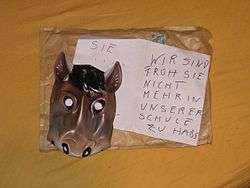Poison pen letter
A poison pen letter is a letter or note containing unpleasant, abusive or malicious statements or accusations about the recipient or a third party. It is usually sent anonymously. Poison pen letters are usually composed and sent to upset the recipient. They differ from blackmail, which is intended to obtain something, in that they are purely malicious.
In the United Kingdom, Section 1 of the Malicious Communications Act 1988 covers most cases of poison pen letters.[1]
In literature and film
- Poison pen letters are a main theme in Dorothy Sayers' novel Gaudy Night, Agatha Christie's The Moving Finger, Henri-Georges Clouzot's Le Corbeau, John Dickson Carr's Night at the Mocking Widow, and Enid Blyton's children's book The Mystery of the Spiteful Letters.
- The British author Richard Llewellyn wrote a successful stage play, Poison Pen: A Play in Three Acts, in 1938, which was later made into a film titled Poison Pen in which Flora Robson, Ann Todd, Reginald Tate and Robert Newton had leading roles.
- In Stieg Larsson's book The Girl Who Kicked the Hornets' Nest, from his Millennium Trilogy, one of the main characters receives anonymous threatening letters from a sender she nicknames "Poison Pen".
- In Paul Magrs's book Something Borrowed, the protagonist begins an investigation into the sender of a poison pen letter.
- In the James Bond film Octopussy, Bond (Roger Moore) jokes that a new gadget, a pen with acidic ink, is "perfect for writing poison pen letters." The gadget's provider, Q, irritatedly responds "Pay attention, 007."
- In the television series Father Brown (episode 9, "The Grim Reaper"), a poison pen letter is used to implicate someone in a murder.
- In the 1967 Film Casino Royale, Peter Sellers (as Evelyn Tremble) makes a Poison Pen Letter joke when introduced with a poisonous gas pen gadget.
See also
References
- ↑ "Communications Offences: Legal Guidance". Crown Prosecution Service. 7 November 2013. Retrieved 10 December 2013.
This article is issued from Wikipedia - version of the 11/23/2016. The text is available under the Creative Commons Attribution/Share Alike but additional terms may apply for the media files.
